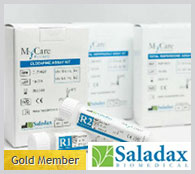Common Bacteria of Gum Disease Linked to Rheumatoid Arthritis
|
By LabMedica International staff writers Posted on 28 Dec 2016 |

Image: A colony of Aggregatibacter actinomycetemcomitans, showing the characteristic flower-like morphology (Photo courtesy of UCL Eastman Dental Institute).
A bacterium known to cause chronic inflammatory periodontal infections may also triggers the inflammatory “autoimmune” response characteristic of chronic, joint-destroying rheumatoid arthritis (RA).
An estimated 1.5 million people nationwide live with rheumatoid arthritis and current treatments with steroids, immunotherapy drugs, and physical therapy help some by reducing or slowing the crippling and painful joint deformities, but not in all patients. The exploration of alternative treatment options is necessary.
Scientists at the Johns Hopkins University School of Medicine (Baltimore, MD, USA) and their colleagues used mass spectrometry to define the microbial composition and antigenic repertoire of gingival crevicular fluid in patients with periodontal disease and healthy controls. Periodontitis was characterized by the presence of citrullinated autoantigens that are primary immune targets in RA. The team developed a test using the bacterium and pore-forming toxin leukotoxin A (LtxA) to detect antibodies against Aggregatibacter actinomycetemcomitans in blood using 196 samples from a large study of patients with RA.
Periodontitis was characterized by the presence of citrullinated autoantigens that are primary immune targets in RA. The citrullinome in periodontitis mirrored patterns of hypercitrullination observed in the rheumatoid joint, implicating this mucosal site in RA pathogenesis. Proteomic signatures of several microbial species were detected in hypercitrullinated periodontitis samples. Among these, A.actinomycetemcomitans, but not other candidate pathogens, induced hypercitrullination in host neutrophils. They identified LtxA as the molecular mechanism by which A.actinomycetemcomitans triggers dysregulated activation of citrullinating enzymes in neutrophils, mimicking membranolytic pathways that sustain autoantigen citrullination in the RA joint.
These data were similar to patients, with periodontal disease with approximately 60% positivity, but quite different in healthy controls, who only had 11% of people positive for A. actinomycetemcomitans. More strikingly, exposure to A. actinomycetemcomitans was a major determinant in the production of antibodies to citrullinated proteins in patients with genetic susceptibility to RA. Moreover, LtxA induced changes in neutrophil morphology mimicking extracellular trap formation, thereby releasing the hypercitrullinated cargo. Exposure to leukotoxic A. actinomycetemcomitans strains was confirmed in patients with RA and was associated with both anticitrullinated protein antibodies and rheumatoid factor. The study was published on December 14, 2016, in the journal Science Translational Medicine.
Related Links:
Johns Hopkins University School of Medicine
An estimated 1.5 million people nationwide live with rheumatoid arthritis and current treatments with steroids, immunotherapy drugs, and physical therapy help some by reducing or slowing the crippling and painful joint deformities, but not in all patients. The exploration of alternative treatment options is necessary.
Scientists at the Johns Hopkins University School of Medicine (Baltimore, MD, USA) and their colleagues used mass spectrometry to define the microbial composition and antigenic repertoire of gingival crevicular fluid in patients with periodontal disease and healthy controls. Periodontitis was characterized by the presence of citrullinated autoantigens that are primary immune targets in RA. The team developed a test using the bacterium and pore-forming toxin leukotoxin A (LtxA) to detect antibodies against Aggregatibacter actinomycetemcomitans in blood using 196 samples from a large study of patients with RA.
Periodontitis was characterized by the presence of citrullinated autoantigens that are primary immune targets in RA. The citrullinome in periodontitis mirrored patterns of hypercitrullination observed in the rheumatoid joint, implicating this mucosal site in RA pathogenesis. Proteomic signatures of several microbial species were detected in hypercitrullinated periodontitis samples. Among these, A.actinomycetemcomitans, but not other candidate pathogens, induced hypercitrullination in host neutrophils. They identified LtxA as the molecular mechanism by which A.actinomycetemcomitans triggers dysregulated activation of citrullinating enzymes in neutrophils, mimicking membranolytic pathways that sustain autoantigen citrullination in the RA joint.
These data were similar to patients, with periodontal disease with approximately 60% positivity, but quite different in healthy controls, who only had 11% of people positive for A. actinomycetemcomitans. More strikingly, exposure to A. actinomycetemcomitans was a major determinant in the production of antibodies to citrullinated proteins in patients with genetic susceptibility to RA. Moreover, LtxA induced changes in neutrophil morphology mimicking extracellular trap formation, thereby releasing the hypercitrullinated cargo. Exposure to leukotoxic A. actinomycetemcomitans strains was confirmed in patients with RA and was associated with both anticitrullinated protein antibodies and rheumatoid factor. The study was published on December 14, 2016, in the journal Science Translational Medicine.
Related Links:
Johns Hopkins University School of Medicine
Latest Immunology News
- Computational Tool Predicts Immunotherapy Outcomes for Metastatic Breast Cancer Patients
- Biomarker Could Predict Immunotherapy Response in Liver Cancer
- Epigenetic Test Could Determine Efficacy of New Immunotherapy Treatments Against Multiple Myeloma
- Blood Test Predicts Survival in Liver Cancer Patients
- Simple Blood Test Identifies Multiple Myeloma Patients Likely to Benefit from CAR-T Immunotherapy
- Portable Device Analyzes White Blood Cell Activity to Monitor Cancer Patients’ Health
- New Test Detects Return of Blood Cancer a Year Earlier
- Universal Blood Test Could Predict Organ Transplant Outcomes with Unprecedented Accuracy
- AI Tool Predicts Cancer Patients’ Response to Immunotherapy
- Molecular Profiling Improves Diagnosis for Children with High Risk Cancers
- Blood Test Measures Immune Response to Epstein-Barr Virus in MS Patients
- AI Predicts Tumor-Killing Cells with High Accuracy
- Diagnostic Blood Test for Cellular Rejection after Organ Transplant Could Replace Surgical Biopsies
- AI Tool Precisely Matches Cancer Drugs to Patients Using Information from Each Tumor Cell
- Genetic Testing Combined With Personalized Drug Screening On Tumor Samples to Revolutionize Cancer Treatment
- Testing Method Could Help More Patients Receive Right Cancer Treatment
Channels
Clinical Chemistry
view channel.jpg)
POC Saliva Testing Device Predicts Heart Failure in 15 Minutes
Heart failure is a serious condition where the heart muscle is unable to pump sufficient oxygen-rich blood throughout the body. It ranks as a major cause of death globally and is particularly fatal for... Read more
Screening Tool Detects Multiple Health Conditions from Single Blood Drop
Infrared spectroscopy, a method using infrared light to study the molecular composition of substances, has been a foundational tool in chemistry for decades, functioning similarly to a molecular fingerprinting... Read more
Integrated Chemistry and Immunoassay Analyzer with Extensive Assay Menu Offers Flexibility, Scalability and Data Commutability
As global healthcare systems increasingly shift towards networked laboratory operational models to enhance efficiency and patient access, there is a greater need for innovative solutions tailored to the... Read moreMolecular Diagnostics
view channel
Respiratory Panel to Help Clinicians Make Precise Treatment Decisions in Outpatient Settings
Respiratory tract infections are the primary reason for visits to emergency departments and subsequent hospitalizations. In the U.S., it is estimated that there are up to 41 million cases of influenza... Read more
Integrating Cardiovascular Risk Biomarkers Aids in Detection of ‘Inflammaging’
Cardiovascular diseases (CVD) continue to be the leading cause of death globally, responsible for nearly one-third of all fatalities worldwide. Traditionally, risk assessment for CVD has focused on well-established... Read more
Genetic Signature in Newborns Predicts Neonatal Sepsis Before Symptoms Appear
Neonatal sepsis, which occurs due to the body’s abnormal response to severe infection within the first 28 days of life, results in approximately 200,000 deaths globally each year. This condition affects around 1.... Read more.jpeg)
Integrating Multiple Protein Markers Predicts Health Outcomes in Chronic Kidney Disease Patients
Previous attempts to discover novel kidney biomarkers as risk factors for chronic kidney disease (CKD) progression have generally focused on evaluating proteins individually, which limits their prognostic... Read moreHematology
view channel
Next Gen CBC and Sepsis Diagnostic System Targets Faster, Earlier, Easier Results
Every hour is critical in protecting patients from infections, yet there are currently limited tools to assist in early diagnosis before patients reach a hospital. The complete blood count (CBC) is a common... Read more
Newly Discovered Blood Group System to Help Identify and Treat Rare Patients
The AnWj blood group antigen, a surface marker discovered in 1972, has remained a mystery regarding its genetic origin—until now. The most common cause of being AnWj-negative is linked to hematological... Read more
Blood Platelet Score Detects Previously Unmeasured Risk of Heart Attack and Stroke
Platelets, which are cell fragments circulating in the blood, play a critical role in clot formation to stop bleeding. However, in some individuals, platelets can become "hyperreactive," leading to excessive... Read moreImmunology
view channel
Computational Tool Predicts Immunotherapy Outcomes for Metastatic Breast Cancer Patients
Immunotherapy aims to enhance the body’s immune response to target cancer cells, but not all patients experience a positive reaction to such treatments. Identifying which patients will benefit from immunotherapy... Read more
Biomarker Could Predict Immunotherapy Response in Liver Cancer
Until recently, patients diagnosed with hepatocellular carcinoma had limited treatment options, with existing therapies extending life by only a few months. Immunotherapy has emerged as a new alternative... Read more
Epigenetic Test Could Determine Efficacy of New Immunotherapy Treatments Against Multiple Myeloma
Multiple myeloma is a blood cancer that primarily affects individuals over the age of sixty, and its occurrence rises as the population ages. In this disease, the bone marrow—the spongy tissue inside bones... Read morePathology
view channel
New Imaging Method Opens Door to Precision Diagnostics for Head and Neck Cancers
Head and neck cancers, while considered rare, represent a significant portion of cancer cases and have seen a notable increase over the past 30 years. These cancers encompass various malignant tumors that... Read more
Faster Measurement of Vibrational Fingerprint of Molecules to Advance Biomedical Diagnostics
Identifying different types of molecules and cells is a vital process in both basic and applied science. Raman spectroscopy serves as a widely utilized measurement technique for this purpose.... Read moreTechnology
view channel
New Noninvasive Methods Detect Lead Exposure Faster, Easier and More Accurately at POC
Exposure to lead can negatively affect health in multiple ways, leading to damage in the brain and central nervous system, delays in development and growth, learning and behavioral issues, problems with... Read more
Noninvasive Test Detects Malaria Without Blood Sample
Malaria remains a significant global health issue, with approximately 250 million cases and over 600,000 deaths reported annually. Nearly half of the world's population is at risk for malaria infection,... Read moreIndustry
view channel
Beckman Coulter Partners with BioPorto for Global Distribution of Acute Kidney Injury NGAL Tests
Acute kidney injury (AKI) is a sudden episode of kidney failure or damage that can occur within a few hours or days. This condition leads to the accumulation of waste products in the blood and disrupts... Read more_1.jpg)
CACLP 2025 New Date and Venue Announced
The 22nd China International In Vitro Diagnostic Expo, organized by the China Association of Clinical Laboratory Practice Expo (CACLP, Shanghai, China), is set to take place from March 21 to 24, 2025,... Read more
Roche to Develop New Diagnostic Technologies for Traumatic Brain Injuries
Traumatic brain injuries (TBI) represent a significant global health issue, affecting approximately 69 million people each year. TBI occurs when an external force disrupts normal brain function, with severity... Read more
















